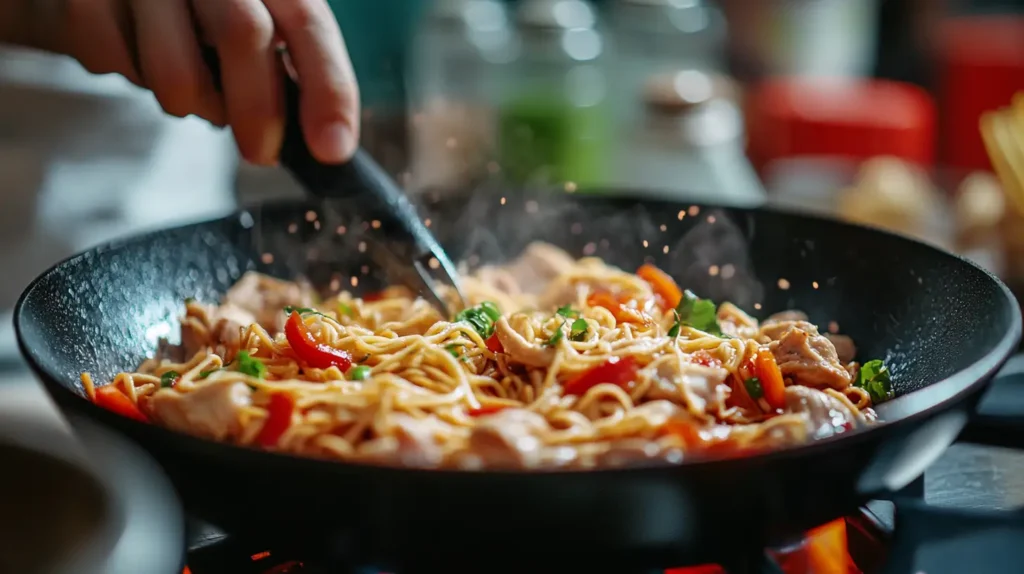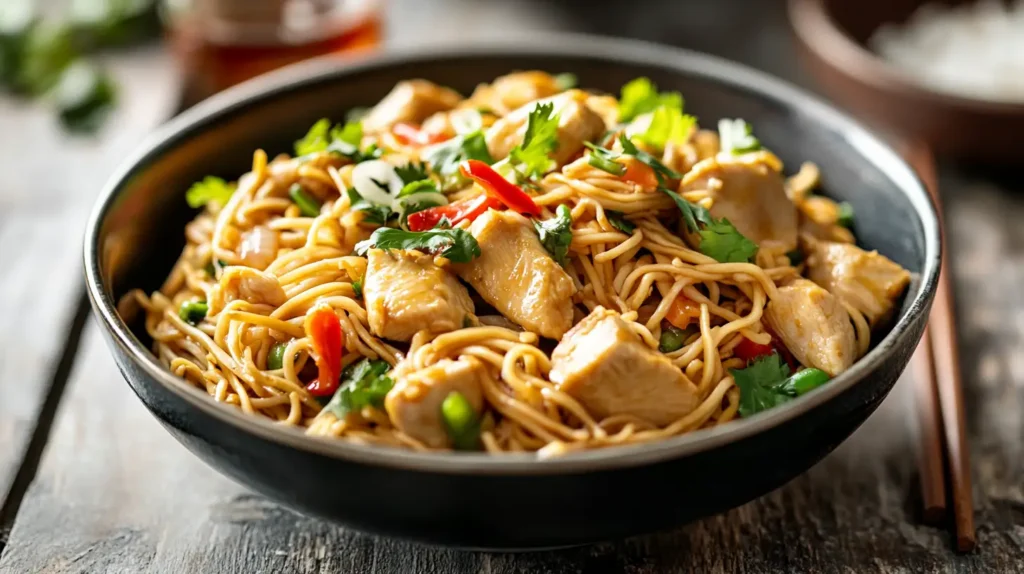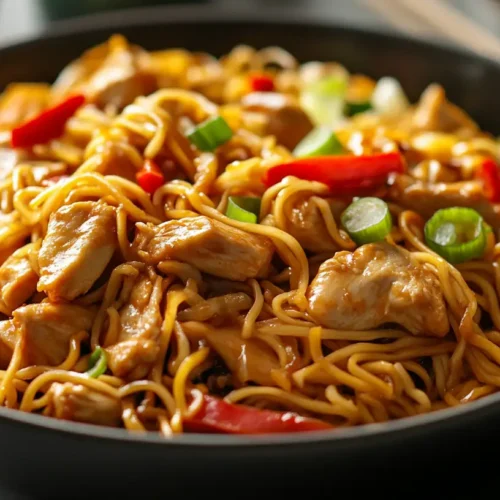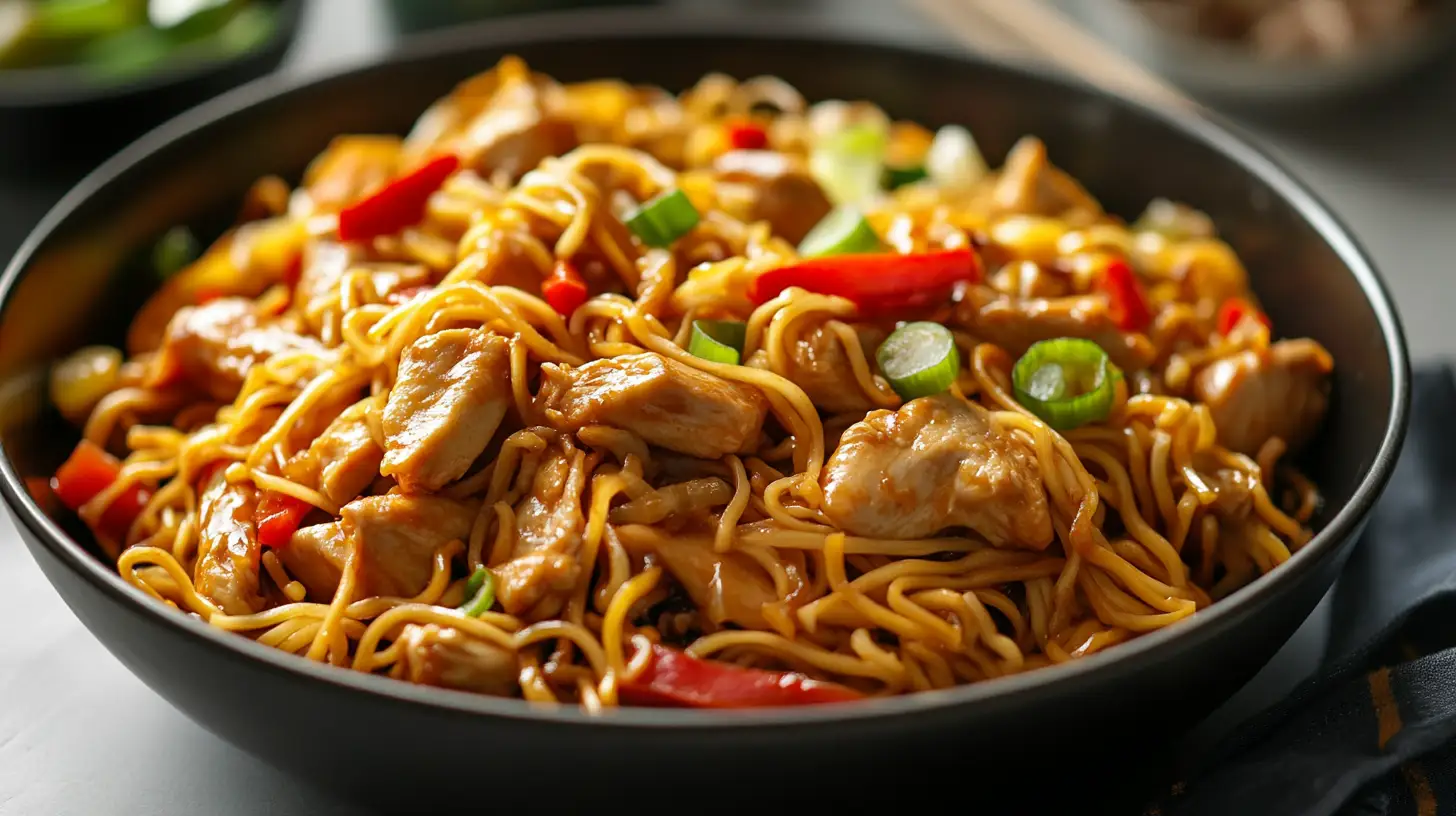Table of Contents
Chicken chow mein one-pot meals are stealing the show in busy kitchens—and for good reason. This dish packs everything you love about takeout into one pan: juicy chicken, crisp veggies, and chewy noodles all smothered in a savory, slurp-worthy sauce. In this guide, we’re diving deep into what makes this one-pan wonder so irresistible, how to whip it up with ease, and the little tricks that take it from good to can’t-stop-eating-it.
You’ll discover why this dish is perfect for weeknights, learn the difference between chow mein and its close cousins, and pick up chef-approved tips for mastering the stir-fry game. Plus, we’ve got a drool-worthy recipe lined up that’ll keep your cleanup simple and your tastebuds dancing.
Let’s kick things off with the heart of what makes this dish click.
Why Everyone’s Obsessed With One-Pot Chicken Chow Mein
Quick, Easy, and Minimal Mess
Let’s be honest, nobody wants to spend hours scrubbing pots after dinner. That’s where the chicken chow mein one-pot magic comes in. You get all the textures and flavors of a classic Chinese noodle dish—without the pile of dishes afterward. It’s fast, it’s fuss-free, and it’s a total weeknight hero.
One pot means:
- Less cleanup, more chill time.
- Fewer steps, more flavor-packed efficiency.
- A whole meal—protein, carbs, and veggies—done in a single pan.
So, whether you’re cooking for two or feeding a crowd, this dish has your back.
A Crowd-Pleaser That’s Surprisingly Healthy
Think Chinese takeout is always greasy? Think again. When you make chicken chow mein one-pot style at home, you’re in full control. Want it light? Use lean chicken breast and go heavy on the veggies. Craving comfort? Opt for soft noodles and rich umami sauce.
Here’s why this dish is winning hearts:
- You can customize it for picky eaters or dietary needs.
- It’s packed with fiber-rich veggies like carrots, cabbage, and bell peppers.
- Using halal-friendly ingredients like low-sodium soy sauce, toasted sesame oil, and fresh chicken keeps things wholesome and inclusive.
Chef’s Tip: Want to amp up the nutrition? Toss in a handful of snap peas or baby spinach in the last minute of cooking.
The Pantry Staples You’ll Always Need
Core Ingredients That Bring It All Together
When it comes to chicken chow mein one-pot, it’s all about smart layering. The secret? Using bold, pantry-friendly ingredients that build flavor fast. Most of what you need is probably already sitting in your kitchen.
Here’s the magic lineup:
- Soy sauce – Go for low-sodium to keep things balanced.
- Sesame oil – Just a few drops add a nutty depth.
- Garlic and ginger – These bring serious zing and warmth.
- Chow mein or egg noodles – Thick enough to hold sauce, but still slurp-worthy.
- Chicken breast or thigh – Lean, tender, and cooks quickly.
- Mixed veggies – Cabbage, carrots, bell peppers, snap peas… whatever you’ve got.
Want to shake things up? Try a splash of rice vinegar or a dash of chili flakes for a little heat. And if you’re out of noodles, rice vermicelli works in a pinch too.
Make It Halal-Friendly Without Fuss
You don’t have to compromise on flavor to make this dish halal-friendly. In fact, it’s incredibly easy. Skip the rice wine or any alcohol-based ingredients found in some traditional recipes and stick to alternatives like rice vinegar or lemon juice.
Use:
- Certified halal chicken (always a must)
- Vegetable or chicken stock instead of wine
- All plant-based oils (no lard or rendered fats)
These tweaks blend in naturally and won’t throw off the taste, so everyone can dig in with peace of mind.
➡️ Love simple one-pan meals with big flavor? You’ll enjoy this Marry Me Chicken Pasta recipe too—it’s creamy, quick, and hits all the right notes.
Cooking Tools That Make It Foolproof
One Pan, One Dream: The Right Pot for the Job
If you’ve ever dealt with noodles sticking, sauce burning, or unevenly cooked chicken, chances are your pan was the problem. For chicken chow mein one-pot dishes to truly shine, the right cookware makes all the difference.
Look for:
- A deep, nonstick skillet or wok – Plenty of room, no sticking.
- Cast iron pan – Great heat retention and flavor searing.
- Lid-compatible – Helps with quick steaming of veggies or softening noodles.
Oh, and always preheat your pan before adding oil—it’s a small step, but it helps prevent sogginess and brings out the flavor of aromatics like garlic and ginger.
Handy Tools That Level Up the Experience
Sure, you could make this with just a knife and spoon… but why not make it easier? These small tools make a big difference in both prep time and final texture.
Must-haves:
- Tongs or chopsticks – For gently turning noodles without breaking them.
- Julienne peeler – Makes veggie prep a breeze.
- Microplane grater – Zests garlic or ginger into the perfect fine paste.
And if you want those restaurant-style noodle vibes? Toss everything in the pan using tongs with a light flick of the wrist—it’s fun and it helps coat every bite evenly in that savory sauce.
Recipe 🌟 – How to Make the Perfect chicken chow mein one-pot
Introduction
Ready to bring your takeout dreams to life—in just one pan? This chicken chow mein one-pot recipe is the real deal. With juicy chicken, crisp-tender veggies, and savory noodles tossed in a glossy, flavor-packed sauce, it’s everything you crave in one stress-free skillet. Perfect for busy weeknights or lazy Sundays, this is comfort food without the cleanup.
Let’s get cooking!
Ingredients 🛒
Here’s what you’ll need:
- 2 tablespoons sesame oil
- 2 cloves garlic, minced
- 1 teaspoon fresh ginger, grated
- 1 pound boneless, skinless chicken breast (thinly sliced)
- 1 red bell pepper, julienned
- 1 cup shredded carrots
- 1 ½ cups green cabbage, thinly sliced
- ½ cup snap peas (optional but awesome)
- 2 tablespoons low-sodium soy sauce
- 1 tablespoon oyster sauce (halal-certified)
- 1 tablespoon dark soy sauce (for color and depth)
- ½ teaspoon black pepper
- 2 teaspoons cornstarch + 2 tablespoons water (slurry)
- 6 oz chow mein noodles or ramen-style wheat noodles
- 2 cups water or unsalted chicken broth
- Chopped scallions and sesame seeds (for garnish)
Directions 👩🍳

- Sear the Chicken: Heat sesame oil in a large nonstick skillet or wok over medium-high. Add garlic and ginger—let them sizzle for 30 seconds. Add chicken and cook until lightly browned and cooked through (5–6 minutes). Remove and set aside.
- Cook the Veggies: In the same pan, toss in carrots, bell pepper, and cabbage. Sauté for 3–4 minutes until slightly softened but still crisp.
- Make the Sauce: Add soy sauces, oyster sauce, black pepper, and broth to the pan. Stir everything together and bring it to a light simmer.
- Add Noodles: Break the noodles into the sauce. Let them simmer for 5–6 minutes until soft, stirring occasionally so they cook evenly and absorb all the flavor.
- Finish Strong: Stir in your cornstarch slurry to thicken the sauce. Add back the cooked chicken and mix well. Cook for another minute until everything’s hot and glossy.
- Garnish & Serve: Top with scallions and sesame seeds. Boom—dinner is served!
Tips & Variations 📌
- Swap chicken with tofu or shrimp for a protein twist.
- Gluten-free? Use tamari instead of soy sauce and gluten-free noodles.
- Toss in extra veggies like mushrooms or baby corn for more texture.
- Want extra sauce? Double the broth and slurry for a looser consistency.
💡 Chef’s Tip: Always slice your chicken thin so it cooks fast and evenly—this keeps the one-pot flow smooth.
Saucy Secrets & Chow Mein FAQs Uncovered
What Is the Sauce in Chow Mein Made Of?
At its heart, chow mein sauce is a savory, umami-loaded combo of soy sauce, sesame oil, garlic, and a hint of sweetness from oyster sauce. That perfect chicken chow mein one-pot flavor comes from the balance—salty, rich, and just a touch of sweetness to round it all out.
One-Pot Convenience With Real Flavor
One-pot doesn’t mean bland—not even close. In fact, cooking everything in one pan helps deepen the flavors. The noodles soak up the sauce, the veggies stay crisp, and the chicken stays juicy. It’s like everything mingles and throws a flavor party in your skillet.
And the best part? You can whip this up in under 30 minutes flat. That’s faster than ordering delivery!
If you love this kind of fuss-free, flavor-forward cooking, you’ll probably enjoy our Cheesy Baked Fajita Chicken—it’s another go-to for quick protein-packed meals.
What’s the Difference Between Chicken Chow Mein and Chicken Lo Mein?
Same Roots, Different Routes
At a glance, chicken chow mein one-pot and lo mein might look like twins. But take a closer bite, and you’ll spot the key difference: texture and technique.
Chow mein—like the one-pot wonder we’re cooking—is usually stir-fried. The noodles are either crispy or slightly chewy depending on the method. Everything is tossed quickly in a hot pan, creating that charred, caramelized edge we all love.
Lo mein, on the other hand, leans saucier. The noodles are boiled separately, then mixed with sauce and stir-fried ingredients at the end. It’s softer, saucier, and a bit heavier on the slurp factor.
Curious to try the flip side? Check out this Easy Chicken Lo Mein Recipe from Simply Recipes. It’s a great intro to the noodle’s smoother, richer cousin.
Which One Should You Make?
It really depends on your vibe.
If you’re craving something with a slight crunch, packed with wok-kissed flavor, chicken chow mein one-pot is your go-to. It’s great for a quick, all-in-one skillet meal. Plus, cleanup? Barely a thing.
But if you’re in the mood for something a little more comforting and saucy, lo mein might win your heart that night.
You know what? Alternate them. Keep your weeknight dinners exciting!
Looking for another bold and saucy chicken option? You might love this rich and easy Chicken Marsala Recipe. It brings the same one-pan simplicity with a totally different flavor profile.
What Sauce Goes Best With Chicken Chow Mein?
The Power of the Perfect Sauce
A great chicken chow mein one-pot dish lives or dies by its sauce. Too salty? It overpowers the chicken. Too sweet? It clashes with the umami. But when you get it just right—it sings.
The go-to combo? A trio of:
- Soy sauce – For that deep, savory backbone.
- Oyster sauce – Adds a sweet-salty kick with depth.
- Dark soy sauce – A dash for color and richness.
Want to jazz it up? Stir in a splash of sesame oil and a touch of chili garlic paste. For those skipping oyster sauce, hoisin works beautifully too.
Flavor Hacks to Level Up Your Sauce
Here’s a fun tip: mix your sauce before adding it to the pan. This gives you full control, prevents over-seasoning, and lets everything coat evenly.
Some home cooks even add a pinch of sugar or honey to round out the saltiness. Others swear by a splash of rice vinegar to balance the richness. Try it both ways and see what hits right for you.
Chef’s Tip: If you’re meal prepping, double the sauce and keep it in the fridge. It stays good for up to a week and works with stir-fries, fried rice, or even grilled chicken.
Easy Adaptations for Every Diet

Make It Vegetarian, Gluten-Free, or Low-Sodium
The beauty of a chicken chow mein one-pot meal? It’s endlessly flexible. Whether you’re cooking for dietary restrictions or simply switching things up, adapting this dish is a breeze.
Want it vegetarian? Swap the chicken for:
- Cubed tofu or tempeh (pan-seared for best texture)
- Mushrooms or edamame for plant-based protein
Need it gluten-free? Use:
- Tamari instead of soy sauce
- Gluten-free noodles (like rice noodles or GF spaghetti)
Going low-sodium? Try:
- Low-sodium broth and soy sauce
- Skip the oyster sauce or use a reduced-salt alternative
You don’t have to ditch flavor to stay on track—just tweak the base and let the sauce carry the dish.
Family-Friendly Swaps That Keep Everyone Happy
Got a picky eater? This is where chicken chow mein one-pot meals shine. It’s customizable without creating extra work.
Try these ideas:
- Use spaghetti noodles if chow mein isn’t available—they absorb flavor beautifully.
- Let kids choose their veggies—think of it as a DIY noodle bar.
- Add a little honey or hoisin for a touch of sweetness if your sauce feels too bold.
For a fun twist, toss in some pineapple chunks or crushed peanuts for crunch. And hey, don’t be afraid to get creative—this is a fridge-friendly dish, after all.

Chicken Chow Mein One-Pot
Equipment
- Nonstick Skillet or Wok
- Tongs
- Knife
Ingredients
Main Ingredients
- 2 tbsp sesame oil
- 2 cloves garlic minced
- 1 tsp fresh ginger grated
- 1 lb chicken breast thinly sliced
- 1 red bell pepper julienned
- 1 cup shredded carrots
- 1.5 cups green cabbage thinly sliced
- 0.5 cup snap peas optional
- 2 tbsp low-sodium soy sauce
- 1 tbsp halal oyster sauce
- 1 tbsp dark soy sauce for color and depth
- 0.5 tsp black pepper
- 2 tsp cornstarch
- 2 tbsp water for slurry
- 6 oz chow mein noodles or ramen-style wheat noodles
- 2 cups water or chicken broth unsalted
- chopped scallions and sesame seeds for garnish
Instructions
- Heat sesame oil in a large skillet or wok. Add garlic and ginger, cook for 30 seconds. Add chicken and cook until browned and cooked through. Remove and set aside.
- Add bell pepper, carrots, cabbage, and snap peas. Sauté for 3–4 minutes until slightly tender.
- Add soy sauces, oyster sauce, black pepper, and broth. Bring to a simmer.
- Add noodles to the pan and cook 5–6 minutes, stirring occasionally, until tender and sauce is absorbed.
- Mix cornstarch with water and stir into the pan. Add chicken back in. Cook 1–2 more minutes until glossy and thickened.
- Garnish with scallions and sesame seeds. Serve hot!
Notes
Final Thoughts + FAQ Recap
Bringing It All Together
If you’ve made it this far, chances are you’re already eyeing your skillet. And why not? Chicken chow mein one-pot meals check every box: fast, easy, customizable, and ridiculously tasty.
It’s the kind of dish you can whip up on a whim, tailor to your taste, and serve up without stressing over cleanup. Plus, it stores like a champ—hello, lunch leftovers.
Your Quick FAQ Recap 🧠
Let’s close with a quick hit list from those burning Google searches:
- What is the sauce in chow mein made of?
Soy sauce, oyster sauce, sesame oil, garlic, and sometimes sugar or vinegar for balance. - How to make an easy chicken chow mein?
Use one pan, fresh veggies, cooked chicken, and noodles. Toss with a quick stir-fry sauce and serve hot. - What’s the difference between lo mein and chow mein?
Chow mein is drier and often crispier from stir-frying. Lo mein is softer, with more sauce and boiled noodles. - What sauce goes best with chicken chow mein?
A balanced mix of soy, oyster sauce, sesame oil, and a touch of sweetness or heat.
So, the next time your stomach growls for takeout, you know exactly what to cook. Trust us, your skillet’s about to become your best friend.
✅ Hungry for more one-pot inspiration? Bookmark this guide—you’ll come back to it often.

